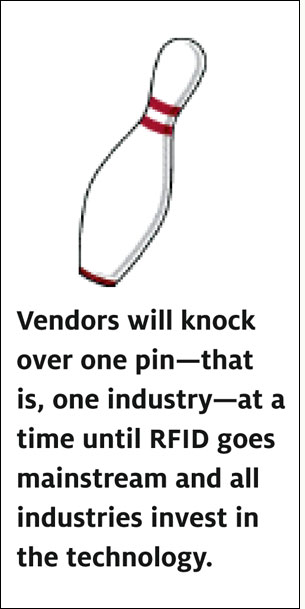Aug 01, 2011In Geoffrey Moore's seminal work on the adoption cycle of new technologies, Crossing the Chasm, he posits that several conditions must exist before a new technology enters the phase of mass adoption, which he calls the "tornado." First, the new technology must be able to solve a problem within an industry that other technologies cannot solve. Second, there must be a global standard. Third, there must be a "whole product"—that is, a complete solution that addresses all aspects of the problem. Fourth, there must be a dominant technology provider—a "gorilla," in Moore's terms. And finally, the industry must reach a critical mass of adoption that causes everyone to adopt the technology in a relatively short time span.
Surveying the world's industries, it's clear the apparel retail and health-care sectors are closest to achieving widespread adoption of RFID technology. Let's look at apparel first. The problem all apparel retailers face is that it's difficult to manage complex inventory—jeans, for example, come in several colors and styles and many sizes. Making sure the optimal number of all these different stock-keeping units is always on the sales floor is a challenge, and no other technology can solve it. (Put a check next to condition one.)
The apparel retail industry has embraced ISO 18000-6C as the standard for tracking clothing (check condition two). Companies such as Checkpoint Systems, Tagsys RFID, Truecount, Tyco Retail Solutions and Xterprise have developed hardware and software solutions that allow retailers to track apparel from the point of manufacture to the point of sale. (Condition three is met.)
And while most retailers have not publicly announced rollouts (Wal-Mart Stores and American Apparel, in the United States, and Gerry Weber International, in Europe, are among the few that have), it's generally known that Banana Republic, JCPenney, Macy's and others are deploying or seeking to deploy the technology. If these chains proceed with full rollouts, the industry will be close to achieving critical mass.
Currently, there's no gorilla in the market—one dominant provider making the whole product. Avery Dennison RFID dominates the RFID transponder business, and Motorola the handheld business. But no single software company has won enough market share to emerge as the clear leader. Once that happens, the industry will have met all the conditions necessary for mass adoption in apparel retail.
Health care also is getting closer to meeting all the conditions Moore lays out for mass adoption. First, hospitals and clinics have a hard time locating and maintaining mobile equipment. Second, the industry appears to be moving toward Wi-Fi-based real-time location systems (RTLSs), because it is the one standard end users can embrace. But it's still too early to rule out Awarepoint, which has been winning deals with its ZigBee-based RTLS, Sonitor with its ultrasound system and a variety of other players with proprietary RTLS solutions.
Many RTLS vendors have developed a complete product that locates assets, issues alerts when assets need maintenance and provides detailed reports on asset utilization. If the industry does embrace Wi-Fi, AeroScout appears to be a candidate for the gorilla role, but it will need to show dominance over Ekahau, which also offers a Wi-Fi-based RTLS.
Achieving critical mass seems to be the biggest challenge in the health-care sector. One reason is that the industry, in the United States at least, is highly fragmented, with many small regional hospital chains. Equipment is used mostly internally, so there is little concern about adopting an industry standard.
That may change soon. The U.S. Veterans Health Administration (VHA) plans to start rolling out RTLS technology as early as April 2012 across all its medical centers—including 152 hospitals, 965 outpatient clinics, 133 community living centers and 96 rehabilitation treatment centers. VHA could encourage more hospital networks in the United States to adopt RFID. The government-run VHA could also encourage countries that have national health systems, such as Canada, France and the United Kingdom, to adopt the technology. All told, that would mean critical mass.
Once apparel retail and health care have begun widespread adoption of passive and active RFID, respectively, the gorillas providing RFID solutions in these sectors will have the resources to enhance their products and target other industries. Moore calls this the "bowling alley." Vendors will knock over one pin—that is, one industry—at a time until RFID goes mainstream and all industries invest in the technology.
The mass adoption of passive RFID technology in retail apparel likely would lead to adoption in other retail sectors, such as consumer electronics, jewelry and sporting goods. As tag volumes rise and prices fall, use of RFID will further expand into tracking lower-cost items, such as toys and consumer-packaged goods.
Adoption of active RFID-based RTLS technology in health care will likely foster adoption of similar systems for tracking mobile equipment in manufacturing. Aerospace and automotive are two industries likely to adopt the technology, because of the sheer size of their facilities and the challenge of tracking tools and equipment within them.
Moore theorizes that one gorilla or a pair of gorillas will dominate all industries, as Microsoft and IBM did in PCs, and as Cisco and Netscape led the adoption of Internet technologies. But it's likely there will be different gorillas in different industries, because software providers focused on manufacturing solutions might gain critical mass before a company that dominates in apparel can gain a foothold.
It's impossible to predict how quickly each industry will move forward with mass adoption, but Moore's theory suggests adoption will accelerate as each sector embraces RFID. That's because vendors have more resources to invest and can quickly develop solutions for additional industries facing similar problems. Perhaps by the end of this decade, most industries will be using RFID technology within their operations.


